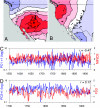Contingent Pacific-Atlantic Ocean influence on multicentury wildfire synchrony over western North America
- PMID: 17197425
- PMCID: PMC1766421
- DOI: 10.1073/pnas.0606078104
Contingent Pacific-Atlantic Ocean influence on multicentury wildfire synchrony over western North America
Abstract
Widespread synchronous wildfires driven by climatic variation, such as those that swept western North America during 1996, 2000, and 2002, can result in major environmental and societal impacts. Understanding relationships between continental-scale patterns of drought and modes of sea surface temperatures (SSTs) such as El Niño-Southern Oscillation (ENSO), Pacific Decadal Oscillation (PDO), and Atlantic Multidecadal Oscillation (AMO) may explain how interannual to multidecadal variability in SSTs drives fire at continental scales. We used local wildfire chronologies reconstructed from fire scars on tree rings across western North America and independent reconstructions of SST developed from tree-ring widths at other sites to examine the relationships of multicentury patterns of climate and fire synchrony. From 33,039 annually resolved fire-scar dates at 238 sites (the largest paleofire record yet assembled), we examined forest fires at regional and subcontinental scales. Since 1550 CE, drought and forest fires covaried across the West, but in a manner contingent on SST modes. During certain phases of ENSO and PDO, fire was synchronous within broad subregions and sometimes asynchronous among those regions. In contrast, fires were most commonly synchronous across the West during warm phases of the AMO. ENSO and PDO were the main drivers of high-frequency variation in fire (interannual to decadal), whereas the AMO conditionally changed the strength and spatial influence of ENSO and PDO on wildfire occurrence at multidecadal scales. A current warming trend in AMO suggests that we may expect an increase in widespread, synchronous fires across the western U.S. in coming decades.
Conflict of interest statement
The authors declare no conflict of interest.
Figures





References
LinkOut - more resources
Full Text Sources

